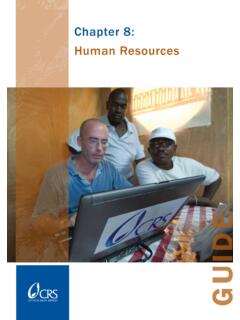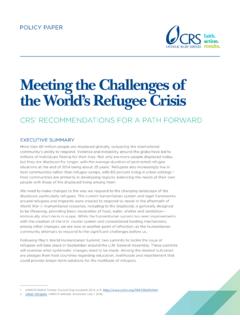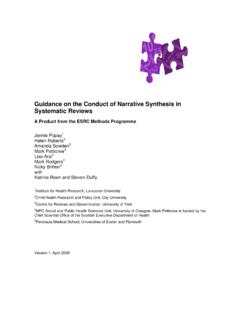Transcription of Tree of Life - Catholic Relief Services
1 1 Third Edition for a Global Audience Adapted by Catholic Relief Services with permission from REPSSI tree of LifePSYCHOSOCIAL WELLBEING SERIESA workshop methodology for children, young people and adults Email: Website: Telephone: +27 11 998 5820 Postal address: PO Box 1669, Randburg, 2125, Johannesburg, South Africa REPSSI is a non-profit organisation working to lessen the devastating social and emotional (psychosocial) impact of poverty, conflict, HIV and AIDS among children and youth. It is led by Noreen Masiiwa Huni, Chief Executive Officer. REPSSI s aim is to ensure that all children have access to stable care and protection through quality psychosocial support. We work at the international, regional and national level in East and Southern best way to support vulnerable children and youth is within a healthy family and community environment. We partner with governments, development partners, international organisations and NGOs to provide programmes that strengthen communities and families competencies to better promote the psychosocial wellbeing of their children and youth.
2 A clear objective of the REPSSI tools for the Psychosocial Wellbeing series of which tree of life is a part -- is to strengthen children s sense of belonging and connectedness to their families and communities, as well as to challenge the sense of isolation and loneliness that many children experience in the context of disease, poverty and conflict. We hope that, in this expanded edition, the tree of life will help many people and organizations around the world in their efforts to improve the wellbeing of Relief Services (CRS) was founded in 1943 by the Catholic Bishops of the United States to serve World War II survivors in Europe. Since then, we have expanded in size to reach 100 million people annually in over 100 countries on five mission is to assist impoverished and disadvantaged people overseas, working in the spirit of Catholic social teaching to promote the sacredness of human life and the dignity of the human person.
3 Catholic Relief Services works in partnership with local, national and international organizations and structures in emergency response, agriculture and health, as well as microfinance, water and sanitation, peace and justice, capacity strengthening, and education. Although our mission is rooted in the Catholic faith, our operations serve people based solely on need, regardless of their race, religion or ethnicity. Within the United States, CRS also engages Catholics to live their faith in solidarity with the poor and suffering people of the Acknowledgements 2 Introduction 3 Part 1 Creating our trees 12 Preparing for part one 12 Participants draw and share their trees 15 Roots of the tree 17 The ground 18 The trunk of the tree 19 The branches of the tree 20 The leaves of the tree 21 The fruits of the tree 22 The Telling 23 Part 2 Forest of life 24 Making the forest 25 Part 3 Storms of life 27 Animals in the forest 30 Taking the lessons home 32 Part 4 Our Trees / Our Lives 33 Certificates and tree of life song 34 Preserving our beautiful trees 36 APPENDIX 1: Energisers 37 APPENDIX 2: Questions for tree of life 38 APPENDIX 3.
4 References 402 AcknowledgementsLike a real tree , the tree of life has grown bigger and more wonderful over the Hope and Sally Timmel published a version of the tree of life in 1984 in their book: Training for Transformation: A handbook for Community Workers, Book 1. Mambo Press, Senga Press, Senga Road, version was further developed and expanded by Ncazelo Ncube-Mlilo (REPSSI) and David Denborough (Dulwich Centre Institute of Community Practice). Sincere appreciation goes to the Dulwich team, David Denborough, Michael White, Cheryl White and Shona Russell, for their encouragement and guidance throughout the shaping of the tree of life project. The tree of life methodology with narrative ideas was first published in the International Journal of narrative Therapy and Community Work in 2006. Many thanks go to the Salvation Army Masiye Camp team over the years for their openness and willingness to share their experiences, including their successes and challenges of working with distressed children.
5 Their experiences, alongside the stories that the children willingly shared, provided the impetus and motivation that led to the development of the tree of life methodology tool. Sincere appreciation also goes to Hope World Wide South Africa - now Olive Leaf Foundation - and its staff and counsellors who displayed amazing enthusiasm in embracing new ideas, demonstrating their desire to provide meaningful support to the children and communities that they serve. Substantive input for the REPSSI publication of the tree of life was provided by Ncazelo Ncube-Mlilo, Jonathan Morgan, Noreen Huni and other REPSSI colleagues. Revisions for the current Third Edition for a Global Audience were prepared by Lucy Y. Steinitz of Catholic Relief Services (CRS) based on input from a tree of life Training of Trainers workshop in June, 2016 in Chennai, India that was co-facilitated by REPSSI s Lynette Mudekunye and Alex Tigere.
6 Many thanks to the Combatting Trafficking in India project of CRS that sponsored that workshop and to all the participants and reviewers in India (Jomey Joseph, project lead) who provided input and support for the current adaptation of this manual. This collaboration between CRS and REPSSI has been a joyful process that we believe will help many more trees sprout and will help many more young people improve their lives wherever they happen to be. 3 IntroductionWhat is the tree of life ?The tree of life is a psychosocial support tool based on narrative practices. It is a tool that uses different parts of a tree as metaphors to represent the different aspects of our lives. It involves people drawing their own tree of life in which they get to speak of their roots (where they come from), their skills and knowledge, their hopes and dreams, and the special people in their lives.
7 The participants then join their trees into a forest of life and, in groups, discuss some of the storms that affect their lives and ways that they respond to these storms, protect themselves, and each other. The use of metaphors and carefully formulated questions invites children and others to tell stories about their lives in ways that make them stronger and more hopeful about the it was not designed for catharsis or as a bereavement tool, the tree of life opens up space to facilitate conversations about hardship, bereavement and loss. It has been used extensively for this purpose with children in many different contexts. The tree of life experience allows children and adults who are severely affected by disease, poverty, violence and conflict to tell, hear, and explore stories of loss without remaining trapped in expressions of negativity or grief. It simultaneously opens up spaces and opportunities to tell, hear and explore stories of hope, shared values and connection to those around them as well as to those who have often report a deeper sense of belonging, identity and inner confidence after completing a tree of life workshop.
8 Through this edition, we hope to extend the experience to an even broader array of contexts, for example in the aftermath of war, humanitarian crises and developed the tree of life , and why?The tree of life methodology was co-developed through a partnership between REPSSI in southern Africa ( ) and Dulwich Centre Foundation in Australia ( ). Ncazelo Ncube (REPSSI) and David Denborough (Dulwich Centre Foundation) initially developed this tree of life approach to assist colleagues who work with children affected by HIV/AIDS in southern Africa. This approach has proved so successful and popular that it is now being used with children, young people, and adults in a wide range of countries across Africa as well as in Australia, Brazil, Canada, Russia, India, Nepal, the USA and elsewhere. The current edition is intended to further expand the tree of life s global reach.
9 It was adapted by Lucy Steinitz and her colleagues at Catholic Relief Services , following a training workshop by REPSSI in Chennai, India in June, tree of life helps participation avoid re-traumatisation (sometimes called secondary traumatisation) that can be caused by the retelling of the original trauma without the appropriate support. By contrast, the tree of life enables people to speak about their lives in ways that are not retraumatising. Instead, the tree of life helps participants strengthen their relationships with their own history, their culture, and significant people in their lives in a positive tree of life utilizes metaphors, which in many cultures and communities evoke powerful meanings and associations for the local people. These meanings and associations embrace important values, skills and knowledge about life . These values, skills and knowledge can support people to find answers to their problems and challenges.
10 In the various contexts where the tree of life tool has been used, people have engaged easily with the tool due to the appealing nature of the metaphors that are associated with it. Who can benefit from the tree of life ?The tree of life has been used to support: Young people affected by HIV and AIDS, and by extreme poverty Children in school and other social settings where they spend their time, for example, in community-based safe-spaces or children s clubs Paraprofessionals working with groups of children affected by conflict and war Children who have lost parents or other loved-ones due to armed conflict Refugees and immigrants People whose communities have suffered from a natural disaster Young people and adults, especially women, who have experienced domestic violence, abuse, trafficking or other forms of exploitation Mental health practitioners working with adults who are experiencing mental health strugglesThe tree of life may also be used as a counselling tool in shelter homes or in conjunction with one-on-one counselling by trained professionals.

















